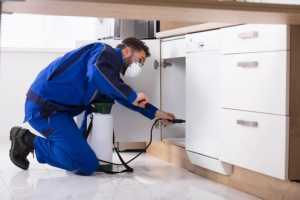Pest control is the application of techniques to reduce damage or destruction by insects, rodents, or other organisms. Museum collections need to manage pests to minimize their impact on our materials and environment. Contact Seaside Pest Control now!
Prevention strategies include:
- Limiting access to food, water, and shelter.
- Installing barriers.
- Removing pests and their nests.
- Creating sanitary storage conditions through well-organized shelving or cabinets

Prevention
Prevention is the best way to reduce pest problems. It involves inspecting the property, identifying the pest, and understanding its biology. Then, you can determine if the problem is worth controlling and which control methods to use.
A good preventive program includes monitoring to identify pests and their damage and removing the conditions that favor them. This can include adjusting irrigation practices to avoid excess watering (which may promote root disease), keeping compost piles away from the house, and reducing clutter where pests hide.
Preventive pest controls are usually less expensive and more environmentally friendly than eradication or suppression. Using the right repellant can be as effective as chemical sprays and may not harm pets or people. Many of these products mimic the scents of spices or predators, so they’re also appealing to humans.
Preventive measures can be as simple as sealing a crack or caulking a hole. Clutter should be removed, garbage disposed of regularly and outdoor trash cans kept closed. Regular inspections should be performed inside and outside to check for gaps, loose siding or cracks that could allow entry. It’s also important to keep landscape trees and shrubs properly trimmed, not to overcrowd them or allow them to touch structures. This allows proper air circulation and helps prevent moisture buildup that can attract pests.
Suppression
There are times when the damage a pest causes makes it necessary to control it. The level of damage determines action thresholds, which can guide control methods that are environmentally conscious and economical.
The best way to prevent a pest from damaging crops is to keep its numbers below harmful levels using natural means. This can include weeding, utilizing tolerant and resistant varieties of plants or animals, and changing growing practices to reduce conditions favorable to the pest.
Biological control is the use of naturally occurring predators, parasitoids, or pathogens to reduce pest populations. These organisms often do not kill the pests they attack but, rather, make the pests less able to survive, grow or reproduce. Examples of useful biological controls include entomogenous (entomopathogenic) nematodes, which are multicellular roundworms that act as predators of some insect pests. See Extension Fact Sheet EEP-7670 for details on the detection, conservation and augmentation of these organisms.
Other biological control methods include the use of plant-parasitic nematodes, which are bacteria associated with fungi that infect and kill insects. Similarly, entomopathogenic nematodes and their associated fungal partners infect and destroy some plant diseases. In addition, certain natural habitats may provide natural enemies that suppress pests in crop fields. For example, in sun-grown Brazilian coffee agroecosystems, the abundance of ant species that are predators of aphids increased with the proximity of fields to forest fragments, and herbivorous beetle suppression in irrigated rice fields was positively related to the number of hedgerows connected to woodlands.
Eradication
The aim of eradication is to cause as little harm as possible to the non-target organisms, while achieving complete or near-complete extinction of the pest. The terms exterminate, extirpate and eradicate are synonymous; they mean to drive something out of existence (as a species, a family or an idea) or to remove it completely from its location.
A successful eradication programme requires planning, monitoring and surveillance. It should start with a delimiting survey, which may be carried out initially or to confirm earlier surveys. Surveillance should continue in accordance with the eradication plan and may include a pathway analysis, inspection of clonally or contact-linked material, trapping and aerial observation. It may also involve enquiries to growers and those responsible for storage and handling facilities, as well as the general public.
An eradication campaign should be initiated before the extent of an infestation reaches a critical threshold and be conducted at local or regional levels rather than at national or international scales. This has been shown to increase the probability of success and reduce the time needed for the pest to be eradicated.
The factors that influence the outcome of an eradication campaign vary between species and locations. They are categorised into those that cannot be changed by the managing authorities, and those that can. The latter have been placed at the top of the classification tree and the former at the bottom.
Integrated Pest Management
Integrated pest management (IPM) is an ecosystem-based strategy that focuses on long-term prevention of pests or their damage through a combination of techniques, including biological control, habitat manipulation, modification of cultural practices and use of resistant varieties. It uses monitoring to assess pest populations and to determine if and when action is needed. Treatments are based on the best available information and minimize risks to people, beneficial insects and the environment.
To be successful, an IPM program needs to involve multiple partners and stakeholders. These include State and Federal agricultural, environmental/non-governmental, and educational organizations; nursery, greenhouse, vegetable and fruit growers; landscapers and grounds keepers; pest control product manufacturers; and the general public. IPM programs must also provide education and training through field and regional workshops and meetings; workshops and conferences; publications; and other media.
By focusing on preventing pest infestations and using chemicals only as a last resort, IPM programs can reduce costs and save time in the field or in the office. They can also help to protect human health, the environment and non-target organisms. For building residents and tenants, IPM can lower maintenance costs by reducing the need for chemical pesticides and improving building conditions that attract and support pests. It can also cut pest complaints by 90 percent. For more information, see Pest Management for Building Residents and Tenants.